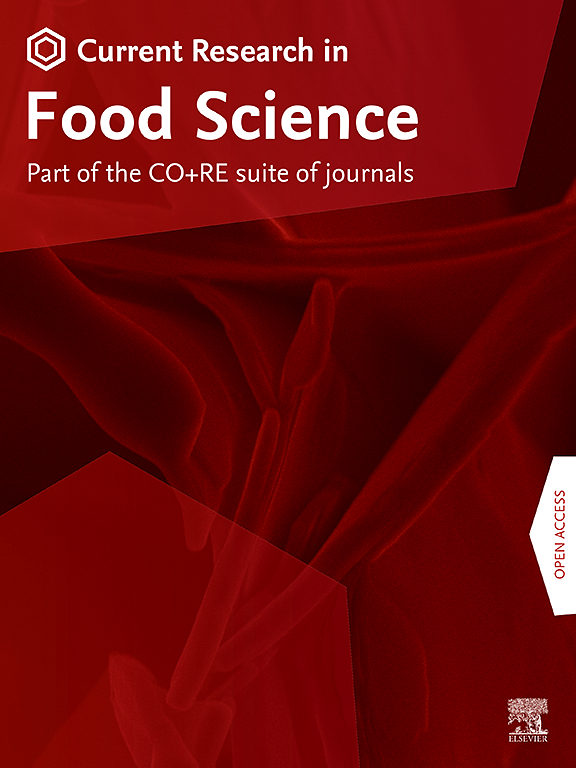用废咖啡渣提高壳聚糖-海藻酸盐食用膜保鲜保鲜性能的研究
IF 7
2区 农林科学
Q1 FOOD SCIENCE & TECHNOLOGY
引用次数: 0
摘要
开发的可食用薄膜,由海藻酸钠、蘑菇衍生的壳聚糖和富含生物活性的咖啡粉提取物配制而成,提供了一种环保的食品保存方法。通过利用农工副产品,该配方显示出符合可持续发展目标的潜在经济和社会效益。本研究开发并优化了一种可持续食用膜,其中含有废咖啡粉提取物(SCGE)作为活性成分。以壳聚糖(0.5 ~ 2.5% w/v)、海藻酸钠(0.5 ~ 2.5% w/v)、甘油(0.5 ~ 2.5% v/v)、SCGE (4 ~ 12% v/v)为研究对象,采用响应面法优化配方。经壳聚糖含量为1.49%、海藻酸钠含量为1.12%、甘油含量为1.53%、SCGE含量为9.69%的最佳膜材,其机械强度(6.33 MPa)、疏水性(78.31°水接触角)和抗氧化能力均有所提高。光谱分析证实了聚合物- scge的强相互作用,提高了结构的完整性和稳定性。在鲜切猕猴桃上涂上该涂层,可显著降低37.5%的水分流失率,延缓了猕猴桃的腐败,并在4℃冷藏10天内保持了猕猴桃的外观和理化特性。这些结果发现,基于scge的可食用薄膜作为一种环保和功能性的包装替代品,利用农业工业废弃物来提高食品质量,延长保质期,并促进当代食品包装的可持续性。本文章由计算机程序翻译,如有差异,请以英文原文为准。

Enhancing the functional properties of chitosan-alginate edible films using spent coffee ground extract for fresh-cut fruit preservation
The developed edible film, formulated using sodium alginate, mushroom-derived chitosan, and bioactive-rich coffee ground extract, offers an environmentally friendly approach to food preservation. By utilizing agro-industrial byproducts, the formulation demonstrates potential economic and social benefits aligned with sustainable development goals. This study developed and optimised a sustainable edible film incorporating spent coffee ground extract (SCGE) as an active ingredient. The formulation was optimised through response surface methodology employing a central composite design, wherein chitosan (0.5–2.5 % w/v), sodium alginate (0.5–2.5 % w/v), glycerol (0.5–2.5 % v/v), and SCGE (4–12 % v/v) were systematically varied. The optimal film (1.49 % chitosan, 1.12 % sodium alginate, 1.53 % glycerol, and 9.69 % SCGE) exhibited enhanced mechanical strength (6.33 MPa), hydrophobicity (78.31° water contact angle), and antioxidant capacity. Spectroscopic analysis confirmed strong polymer–SCGE interactions, improving structural integrity and stability. Applying the coating to fresh-cut kiwi fruit notably decreased moisture loss by 37.5 %, delayed spoilage, and maintained appearance, and physicochemical characteristics over 10 days of cold storage at 4 °C. These results found SCGE-based edible films as an eco-friendly and functional packaging alternative, utilizing agro-industrial waste to enhance food quality, extend shelf life, and promote sustainability in contemporary food packaging.
求助全文
通过发布文献求助,成功后即可免费获取论文全文。
去求助
来源期刊

Current Research in Food Science
Agricultural and Biological Sciences-Food Science
CiteScore
7.40
自引率
3.20%
发文量
232
审稿时长
84 days
期刊介绍:
Current Research in Food Science is an international peer-reviewed journal dedicated to advancing the breadth of knowledge in the field of food science. It serves as a platform for publishing original research articles and short communications that encompass a wide array of topics, including food chemistry, physics, microbiology, nutrition, nutraceuticals, process and package engineering, materials science, food sustainability, and food security. By covering these diverse areas, the journal aims to provide a comprehensive source of the latest scientific findings and technological advancements that are shaping the future of the food industry. The journal's scope is designed to address the multidisciplinary nature of food science, reflecting its commitment to promoting innovation and ensuring the safety and quality of the food supply.
 求助内容:
求助内容: 应助结果提醒方式:
应助结果提醒方式:


